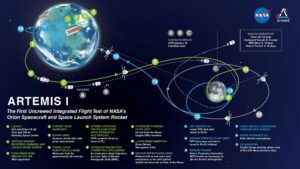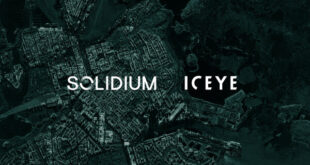 By Emma Gatti
By Emma Gatti
The 2021 Wernher Von Braun Symposium, October 12 – 14, an annual event that brings together the rocket, propulsion and aerospace part of the NASA community, has just ended in Huntsville, Alabama. This year’s priorities were linked to the upcoming launch of Artemis I, the first unmanned phase of the long-term Artemis project, to future Artemis missions and to the long-term establishment of a Moon base. The SLS (Space Launch System) has been announced as “almost ready to fly” by both Sharon Cobb (Associate Program Manager for the Space Launch System at NASA’s Marshall Space Flight Center) and Jeremy Parsons (Deputy Manager, Exploration Ground Systems Program at NASA Kennedy Space Center). By the 20th of October 2021 the Orion spacecraft, the last missing piece, should be attached to the SLS, and they will then proceed with the final phases of configuration. The launch date for Artemis I has not been set yet, but should be revealed soon.

Credits: NASA
The establishment of a Lunar Surface Innovation Consortium has been promoted to engage the community, academia and the industry sector in the Artemis project at large, said Jim Reuter (NASA technology mission directorate’s associate administrator). Among the future payloads and technologies linked to Artemis presented, there were vertical solar array technologies, PRIME-1 – a polar resources ice mining experiment, and Viper – NASA’s Volatiles Investigating Polar Exploration Rover-.
The symposium also tackled the current issues the Space sector is called to face, such as the need for regulations for space traffic management and the funding of the commercial space sector. Wayne Monteith (Associate Administrator, Office of Commercial Space Transportation, FAA) in particular called for the need of a modernized regulatory framework, to keep pace with the rapidly developing Space business. Carissa Christensen (Chief Executive Officer at BryceTech) when asked what were the best ways to fund the private space sector, replied that the three main approaches are revenue, venture capital and government investments. Bill Read (Chief Financial Officer at Redwire Space), highlighted how manufacturing and mining of space resources could represent such revenue.
The return of nuclear power was also discussed, with new fission propulsion systems studied to reduce the size of the vehicle, the length of the journey and the amount of fuel needed. Fission propulsion reactors are still at an experimental level, but several startups and established companies such as BWXT, X-Energy (which also collaborates with the US Department of Defense) and USNC-Tech (Ultra Safe Nuclear-Tech) were invited to share their most recent results. The nuclear possibilities were discussed from a technology viewpoint, and not from an environmental or security perspective at this stage.
The symposium concluded with a future vision for the aerospace field, calling for sustainable, environmentally-responsible and technologically cutting-edge developments, to foster economic growth and a fluid interaction between the aerospace business sector and the American nation.

Emma Gatti is a Cambridge graduated and former NASA scientist with ten years of experience in the field of planetary science and geology. She was working as a post-doctoral scholar at Jet Propulsion Laboratory and California Institute of Technology before returning to Milan in 2018 to start working as space journalist in the field of Space Economy and Space Policy. She is particularly interested in space colonization, planetary mining and everything regulating the two. She likes Italian coffee, Indian food, French wine, Dutch beer, Swiss trains, Danish policy, Russian theatre, Brazilian cocktails, Egyptian tombs, English television, Australian attitude and American literature.
 SpaceWatch.Global An independent perspective on space
SpaceWatch.Global An independent perspective on space




